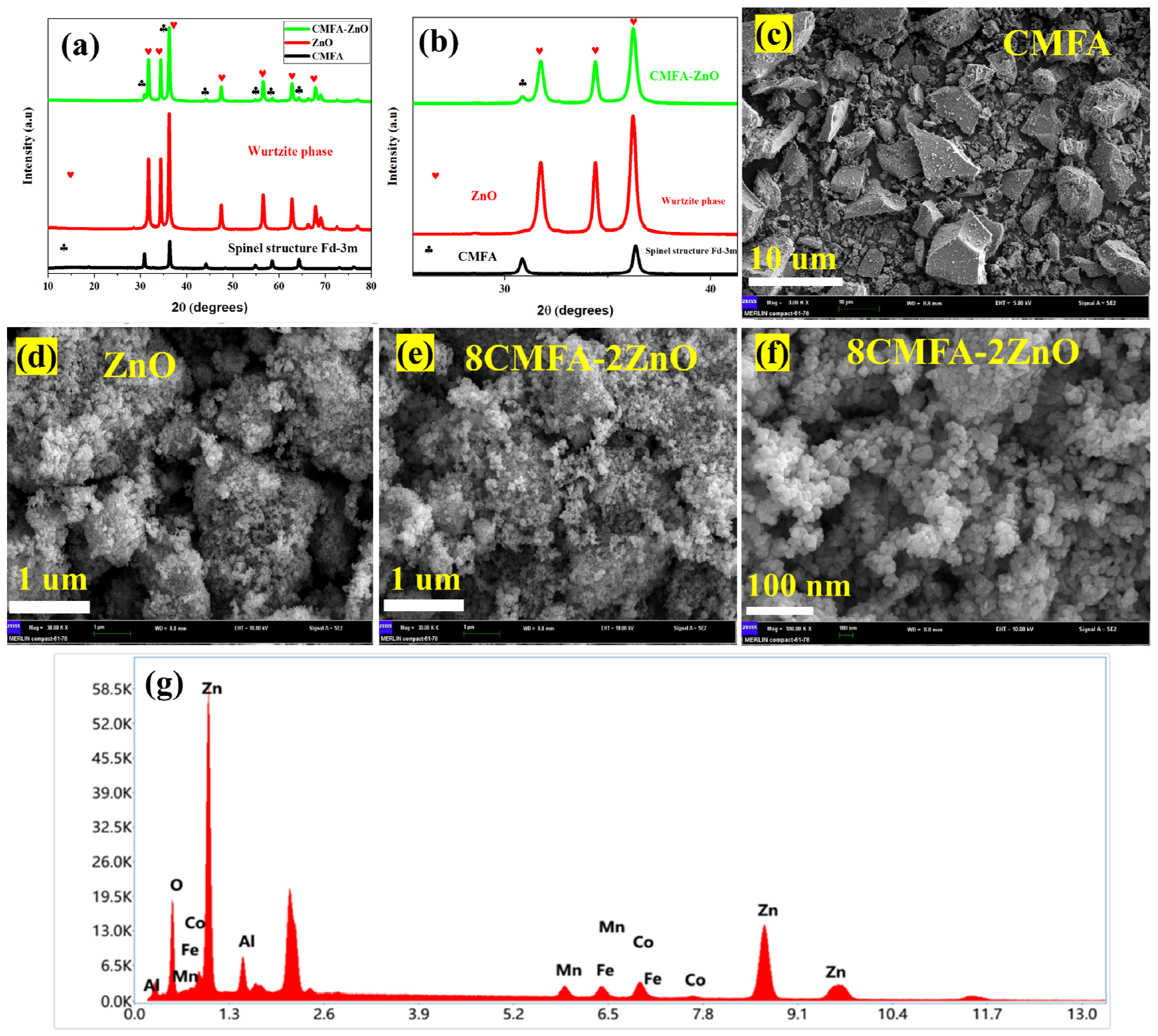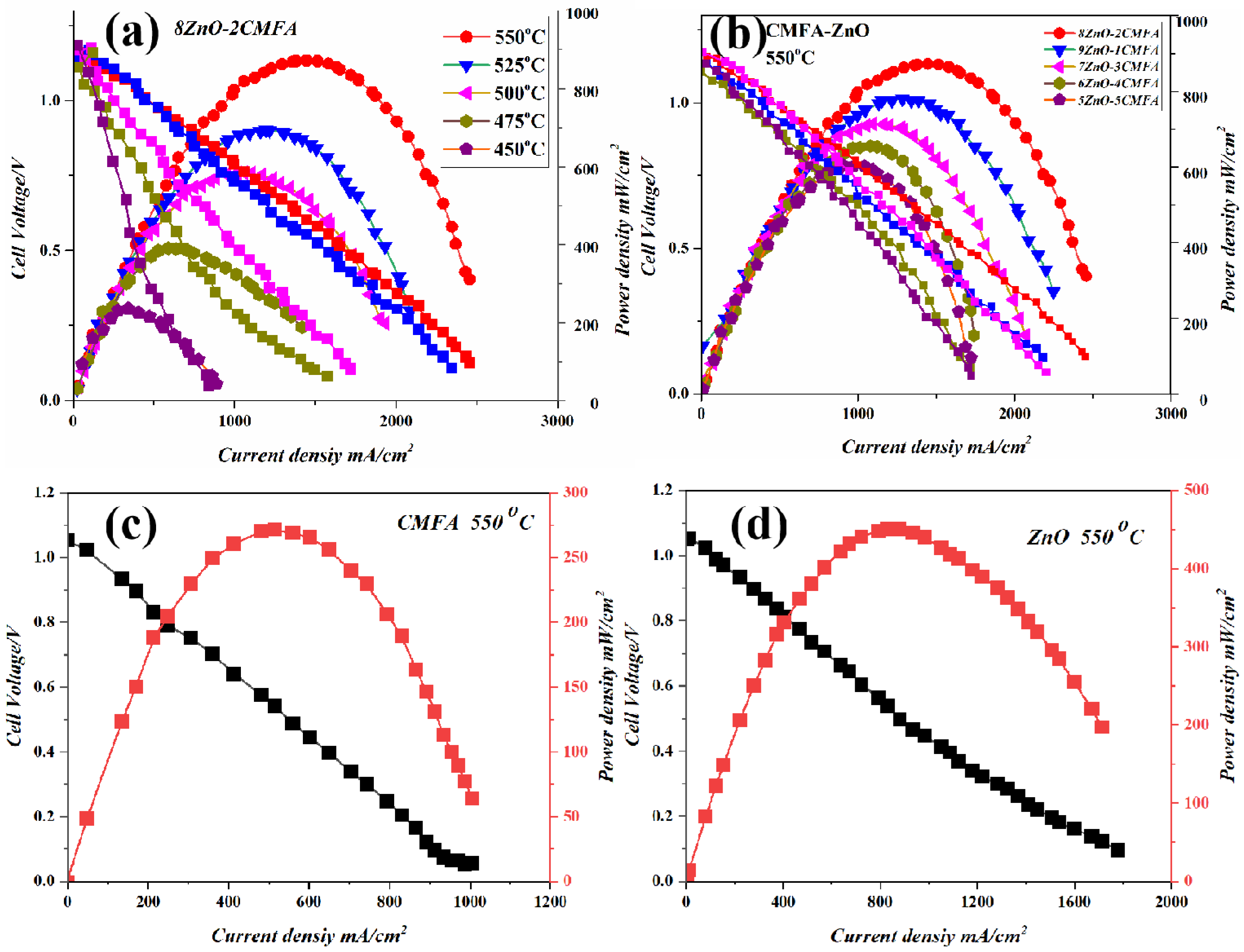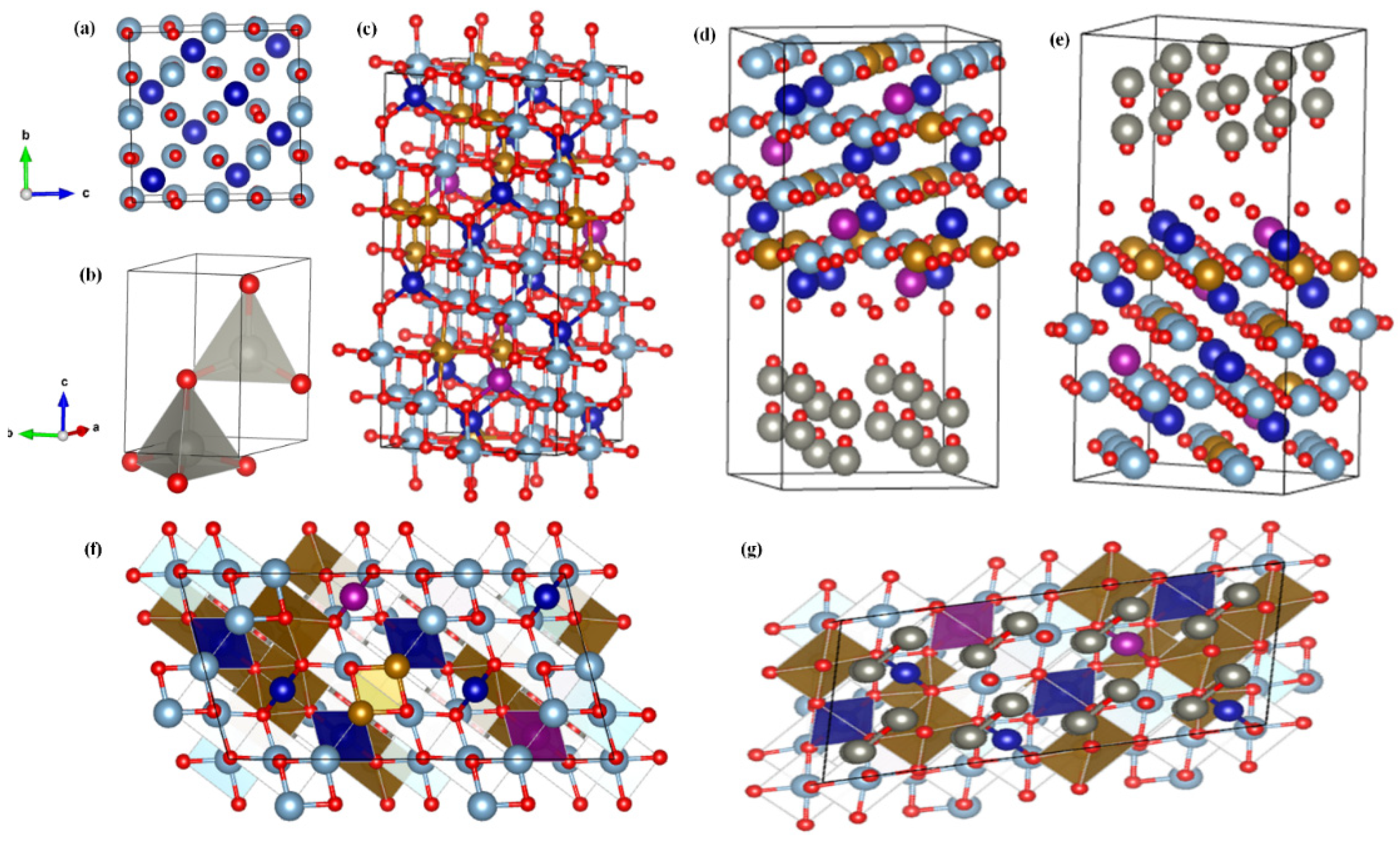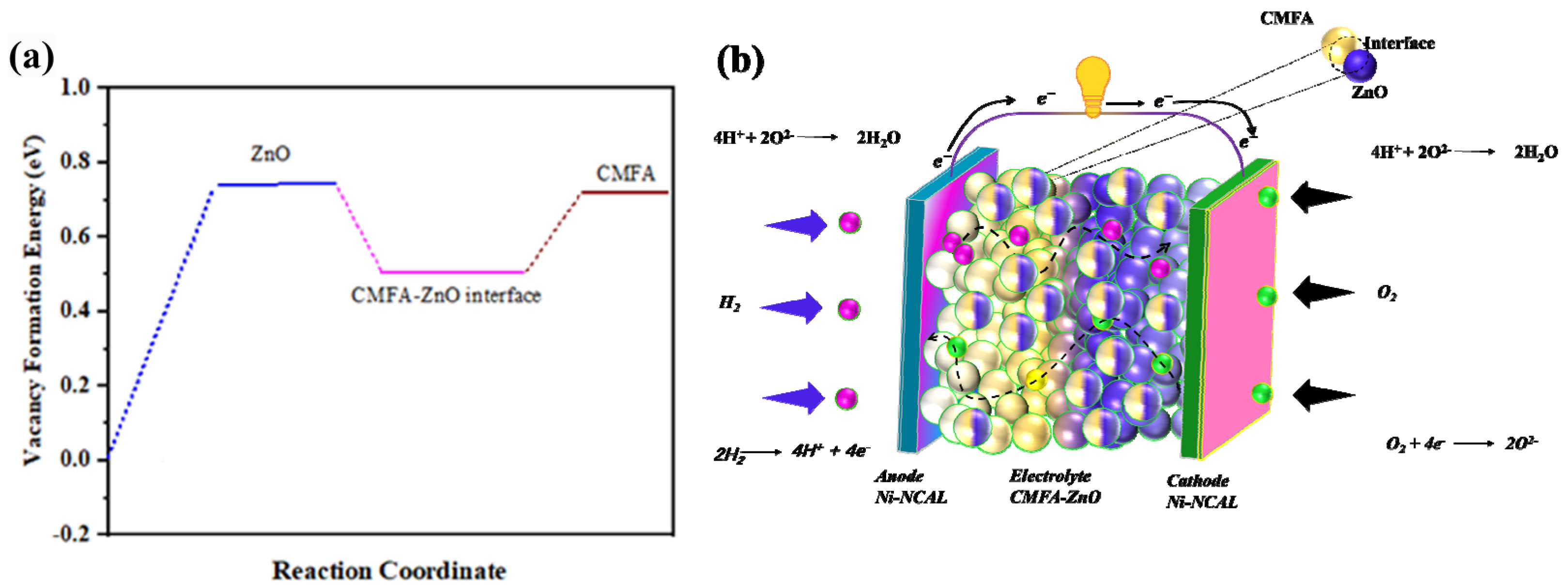Improved Ionic Transport Using a Novel Semiconductor Co0.6Mn0.4Fe0.4Al1.6O4 and Its Heterostructure with Zinc Oxide for Electrolyte Membrane in LT-CFCs
Abstract
1. Introduction
2. Materials and Methods
2.1. Preparation of CMFA–ZnO Heterostructure Composite
2.1.1. Preparation of Co0.6Mn0.4Fe0.4Al1.6O4
2.1.2. Preparation of Superlattice Heterostructures
2.2. Experimental Characterizations
2.3. Device Fabrications and Electrochemical Measurements
2.4. Computational Methods
3. Results and Discussion
Structural and Cation Arrangement
4. Conclusions
Author Contributions
Funding
Data Availability Statement
Acknowledgments
Conflicts of Interest
References
- Foger, K. Challenges in Commercialization of Ceramic Fuel Cells Highly Efficient Residential Generator BlueGen in Europe, Okinawa. In Proceedings of the SOFC-XIII Satellite Seminar, Naha, Japan, 6–11 October 2013; Volume 10. Available online: http://www.ee.mech.tohoku.ac.jp/SOFC-XIII/program/satellite.html (accessed on 25 February 2023).
- Privette, R.; Perna, M.; Kneidel, K. Status of SOFC Technology Development; Fuel Cell Seminar Organizing Committee: Washington, DC, USA, 1996. [Google Scholar] [CrossRef]
- Singhal, S. SOFC Market and Commercialization: Overview, Okinawa. In Proceedings of the SOFC-XIII Satellite Seminar, Naha, Japan, 6–11 October 2013; Volume 10. Available online: http://www.ee.mech.tohoku.ac.jp/SOFC-XIII/program/The%20SOFC-XIII%20Satellite%20Seminar(20130828).pdf (accessed on 25 February 2023).
- Han, M.; Tang, X.; Yin, H.; Peng, S. Fabrication, microstructure and properties of a YSZ electrolyte for SOFCs. J. Power Source 2007, 165, 757–763. [Google Scholar] [CrossRef]
- Saebea, D.; Authayanun, S.; Patcharavorachot, Y.; Chatrattanawet, N.; Arpornwichanop, A. Electrochemical performance assessment of low-temperature solid oxide fuel cell with YSZ-based and SDC-based electrolytes. Int. J. Hydrogen Energy 2018, 43, 921–931. [Google Scholar] [CrossRef]
- Naiqing, Z.; Kening, S.; Derui, Z.; Dechang, J. Study on Properties of LSGM Electrolyte Made by Tape Casting Method and Applications in SOFC. J. Rare Earths 2006, 24, 90–92. [Google Scholar] [CrossRef]
- Steele, B. Appraisal of Ce Gd O electrolytes for IT-SOFC operation at 12y22y/25008C. Solid State Ionics 2000, 129, 95–110. [Google Scholar] [CrossRef]
- Chen, Y.-Y.; Wei, W.-C.J. Processing and characterization of ultra-thin yttria-stabilized zirconia (YSZ) electrolytic films for SOFC. Solid State Ionics 2006, 177, 351–357. [Google Scholar] [CrossRef]
- Choi, S.M.; An, H.; Yoon, K.J.; Kim, B.-K.; Lee, H.-W.; Son, J.-W.; Kim, H.; Shin, D.; Ji, H.-I.; Lee, J.-H. Electrochemical analysis of high-performance protonic ceramic fuel cells based on a columnar-structured thin electrolyte. Appl. Energy 2018, 233–234, 29–36. [Google Scholar] [CrossRef]
- Hu, E.; Jiang, Z.; Fan, L.; Singh, M.; Wang, F.; Raza, R.; Sajid, M.; Wang, J.; Kim, J.-S.; Zhu, B. Junction and energy band on novel semiconductor-based fuel cells. iScience 2021, 24, 102191. [Google Scholar] [CrossRef] [PubMed]
- Liu, J.; Zhu, D.; Zhu, C.; Jing, Y.; Jia, X.; Zhang, Y.; Yang, M.; Yu, J.; Fan, L.; Asghar, M.I.; et al. A heterostructure p-n junction constituting of fluorite and perovskite semiconductors for electrochemical energy conversion. Energy Convers. Manag. 2022, 269, 116107. [Google Scholar] [CrossRef]
- Zhu, B.; Fan, L.; Mushtaq, N.; Raza, R.; Sajid, M.; Wu, Y.; Lin, W.; Kim, J.-S.; Lund, P.D.; Yun, S. Semiconductor Electrochemistry for Clean Energy Conversion and Storage. Electrochem. Energy Rev. 2021, 4, 757–792. [Google Scholar] [CrossRef]
- Shah, M.Y.; Lu, Y.; Mushtaq, N.; Rauf, S.; Yousaf, M.; Asghar, M.I.; Lund, P.D.; Zhu, B. Demonstrating the potential of iron-doped strontium titanate electrolyte with high-performance for low temperature ceramic fuel cells. Renew. Energy 2022, 196, 901–911. [Google Scholar] [CrossRef]
- Shah, M.Y.; Rauf, S.; Mushtaq, N.; Tayyab, Z.; Ali, N.; Yousaf, M.; Xing, Y.; Akbar, M.; Lund, P.D.; Yang, C.P.; et al. Semiconductor Fe-doped SrTiO3-δ perovskite electrolyte for low-temperature solid oxide fuel cell (LT-SOFC) operating below 520 °C. Int. J. Hydrogen Energy 2020, 45, 14470–14479. [Google Scholar] [CrossRef]
- Zhou, Y.; Guan, X.; Zhou, H.; Ramadoss, K.; Adam, S.; Liu, H.; Lee, S.; Shi, J.; Tsuchiya, M.; Fong, D.D.; et al. Strongly correlated perovskite fuel cells. Nature 2016, 534, 231–234. [Google Scholar] [CrossRef] [PubMed]
- Chen, G.; Liu, H.; He, Y.; Zhang, L.; Asghar, M.I.; Geng, S.; Lund, P.D. Electrochemical mechanisms of an advanced low-temperature fuel cell with a SrTiO3 electrolyte. J. Mater. Chem. A 2019, 7, 9638–9645. [Google Scholar] [CrossRef]
- Rauf, S.; Hanif, M.B.; Mushtaq, N.; Tayyab, Z.; Ali, N.; Shah, M.A.K.Y.; Motola, M.; Saleem, A.; Asghar, M.I.; Iqbal, R.; et al. Modulating the Energy Band Structure of the Mg-Doped Sr0.5Pr0.5Fe0.2Mg0.2Ti0.6O3−δ Electrolyte with Boosted Ionic Conductivity and Electrochemical Performance for Solid Oxide Fuel Cells. ACS Appl. Mater. Interfaces 2022, 14, 43067–43084. [Google Scholar] [CrossRef]
- Shah, M.A.K.Y.; Lu, Y.; Mushtaq, N.; Rauf, S.; Yousaf, M.; Zhu, B. Surface and interfacial conduction using gadolinium-doped ceria electrolyte for advanced low temperature 400–500 °C fuel cell. Electrochim. Acta 2022, 439, 141592. [Google Scholar] [CrossRef]
- Shah, M.Y.; Lu, Y.; Mushtaq, N.; Yousaf, M.; Rauf, S.; Asghar, M.I.; Lund, P.D.; Zhu, B. Perovskite Al-SrTiO3 semiconductor electrolyte with superionic conduction in ceramic fuel cells. Sustain. Energy Fuels 2022, 6, 3794–3805. [Google Scholar] [CrossRef]
- Yousaf, M.; Akbar, M.; Shah, M.Y.; Noor, A.; Lu, Y.; Akhtar, M.N.; Mushtaq, N.; Hu, E.; Yan, S.; Zhu, B. Enhanced ORR catalytic activity of rare earth-doped Gd oxide ions in a CoFe2O4 cathode for low-temperature solid oxide fuel cells (LT-SOFCs). Ceram. Int. 2022, 48, 28142–28153. [Google Scholar] [CrossRef]
- Xia, C.; Mi, Y.; Wang, B.; Lin, B.; Chen, G.; Zhu, B. Shaping triple-conducting semiconductor BaCo0.4Fe0.4Zr0.1Y0.1O3-δ into an electrolyte for low-temperature solid oxide fuel cells. Nat. Commun. 2019, 10, 1707. [Google Scholar] [CrossRef]
- Shah, M.A.K.Y.; Mushtaq, M.; Rauf, S.; Xia, C. The semiconductor SrFe0.2Ti0.8O3-δ-ZnO heterostructure electrolyte fuel cells. Int. J. Hydrogen Energy 2019, 44, 30319–30327. [Google Scholar] [CrossRef]
- Shah, M.; Lu, Y.; Mushtaq, N.; Yousaf, M.; Zhu, B. Interfacial active-sites p-n heterojunction SFT-WO3 for enhanced fuel cell performance at 400–500 °C. Mater. Today Sustain. 2022, 20, 100229. [Google Scholar] [CrossRef]
- Akbar, N.; Paydar, S.; Afzal, M.; Akbar, M.; Shah, M.A.K.Y.; Ge, W.; Zhu, B. Tunning tin-based perovskite as an electrolyte for semiconductor protonic fuel cells. Int. J. Hydrogen Energy 2021, 47, 5531–5540. [Google Scholar] [CrossRef]
- Paydar, S.; Akbar, N.; Shi, Q.; Wu, Y. Developing cuprospinel CuFe2O4–ZnO semiconductor heterostructure as a proton conducting electrolyte for advanced fuel cells. Int. J. Hydrogen Energy 2020, 46, 9927–9937. [Google Scholar] [CrossRef]
- Shah, M.Y.; Lu, Y.; Mushtaq, N.; Singh, M.; Rauf, S.; Yousaf, M.; Zhu, B. ZnO/MgZnO heterostructure membrane with type II band alignment for ceramic fuel cells. Energy Mater. 2022, 2, 200031. [Google Scholar] [CrossRef]
- Mushtaq, N.; Lu, Y.; Xia, C.; Dong, W.; Wang, B.; Shah, M.Y.; Rauf, S.; Akbar, M.; Hu, E.; Raza, R.; et al. Promoted electrocatalytic activity and ionic transport simultaneously in dual functional Ba0.5Sr0.5Fe0.8Sb0.2O3-δ-Sm0.2Ce0.8O2-δ heterostructure. Appl. Catal. B Environ. 2021, 298, 120503. [Google Scholar] [CrossRef]
- Mushtaq, N.; Lu, Y.; Xia, C.; Dong, W.; Wang, B.; Wang, X.; Shah, M.Y.; Rauf, S.; Nie, J.; Hu, E.; et al. Design principle and assessing the correlations in Sb-doped Ba0.5Sr0.5FeO3–δ perovskite oxide for enhanced oxygen reduction catalytic performance. J. Catal. 2021, 395, 168–177. [Google Scholar] [CrossRef]
- Wang, J.; Lu, Y.; Mushtaq, N.; Shah, M.Y.; Rauf, S.; Lund, P.D.; Asghar, M.I. Novel LaFe2O4 spinel structure with a large oxygen reduction response towards protonic ceramic fuel cell cathode. J. Rare Earths 2023, 41, 413–421. [Google Scholar] [CrossRef]
- Wang, B.; Zhu, B.; Yun, S.; Zhang, W.; Xia, C.; Afzal, M.; Cai, Y.; Liu, Y.; Wang, Y.; Wang, H. Fast ionic conduction in semiconductor CeO2-δ electrolyte fuel cells. NPG Asia Mater. 2019, 11, 1–12. [Google Scholar] [CrossRef]
- Patade, S.R.; Andhare, D.D.; Kharat, P.B.; Humbe, A.V.; Jadhav, K. Impact of crystallites on enhancement of bandgap of Mn1-xZnxFe2O4 (1 ≥ x ≥ 0) nanospinels. Chem. Phys. Lett. 2020, 745, 137240. [Google Scholar] [CrossRef]
- Lan, R.; Tao, S. Novel proton conductors in the layered oxide material LixlAl0.5Co0.5O2. Adv. Energy Mater. 2014, 4, 1301683. [Google Scholar] [CrossRef]
- Zhu, B.; Lund, P.D.; Raza, R.; Ma, Y.; Fan, L.; Afzal, M.; Patakangas, J.; He, Y.; Zhao, Y.; Tan, W.; et al. Schottky Junction Effect on High Performance Fuel Cells Based on Nanocomposite Materials. Adv. Energy Mater. 2015, 5, 1401895. [Google Scholar] [CrossRef]
- Chandramohan, P.; Srinivasan, M.; Velmurugan, S.; Narasimhan, S. Cation distribution and particle size effect on Raman spectrum of CoFe2O4. J. Solid State Chem. 2011, 184, 89–96. [Google Scholar] [CrossRef]
- Xia, C.; Qiao, Z.; Shen, L.; Liu, X.; Cai, Y.; Xu, Y.; Qiao, J.; Wang, H. Semiconductor electrolyte for low-operating-temperature solid oxide fuel cell: Li-doped ZnO. Int. J. Hydrogen Energy 2018, 43, 12825–12834. [Google Scholar] [CrossRef]
- Khan, M.A.; Raza, R.; Lima, R.B.; Chaudhry, M.A.; Ahmed, E.; Khalid, N.; Abbas, G.; Zhu, B.; Nasir, N. Effect of titania concentration on the grain boundary conductivity of calcium-doped ceria electrolyte. Ceram. Int. 2014, 40, 9775–9781. [Google Scholar] [CrossRef]
- Lee, W.; Jung, H.J.; Lee, M.H.; Kim, Y.-B.; Park, J.S.; Sinclair, R.; Prinz, F.B. Oxygen Surface Exchange at Grain Boundaries of Oxide Ion Conductors. Adv. Funct. Mater. 2011, 22, 965–971. [Google Scholar] [CrossRef]
- Zhou, X.; Xia, C.; Wang, X.; Dong, W.; Wang, B. Improving Grain Boundary Conductivity of Ce0.9Gd0.1O2−δ Electrolyte through Compositing with Carbonate or Semiconductor. Energy Technol. 2020, 8, 2000424. [Google Scholar] [CrossRef]
- Afzal, M.; Saleemi, M.; Wang, B.; Xia, C.; Zhang, W.; He, Y.; Jayasuriya, J.; Zhu, B. Fabrication of novel electrolyte-layer free fuel cell with semi-ionic conductor (Ba0.5Sr0.5Co0.8Fe0.2O3−δ- Sm0.2Ce0.8O1.9) and Schottky barrier. J. Power Source 2016, 328, 136–142. [Google Scholar] [CrossRef]
- Rauf, S.; Zhu, B.; Shah, M.; Tayyab, Z.; Attique, S.; Ali, N.; Mushtaq, N.; Asghar, M.; Lund, P.; Yang, C. Low-temperature solid oxide fuel cells based on Tm-doped SrCeO2-δ semiconductor electrolytes. Mater. Today Energy 2021, 20, 100661. [Google Scholar] [CrossRef]
- Mushtaq, N.; Xia, C.; Dong, W.; Wang, B.; Raza, R.; Ali, A.; Afzal, M.; Zhu, B. Tuning the energy band structure at interfaces of the SrFe0.75Ti0.25O3−δ–Sm0.25Ce0.75O2−δ heterostructure for fast ionic transport. ACS Appl. Mater. Interfaces 2019, 11, 38737–38745. [Google Scholar] [CrossRef]
- Xing, Y.; Hu, E.; Wang, F.; Muhammad, N.; Wang, B.; Wang, J.; Maryam, A.; Rasheed, M.N.; Asghar, M.; Xia, C.; et al. Cubic silicon carbide/zinc oxide heterostructure fuel cells. Appl. Phys. Lett. 2020, 117, 162105. [Google Scholar] [CrossRef]
- Baliga, B.J. Power Semiconductor Devices (General Engineering); PWS Pub. Co.: Delhi, India, 1995. [Google Scholar]
- Li, C.; Dong, S.; Tang, R.; Ge, X.; Zhang, Z.; Wang, C.; Lu, Y.; Yin, L. Heteroatomic interface engineering in MOF-derived carbon heterostructures with built-in electric-field effects for high performance Al-ion batteries. Energy Environ. Sci. 2018, 11, 3201–3211. [Google Scholar] [CrossRef]
- Shah, M.A.K.Y.; Zhu, B.; Rauf, S.; Mushtaq, N.; Yousaf, M.; Ali, N.; Tayyab, Z.; Akbar, N.; Yang, C.P.; Wang, B. Electrochemical Properties of a Co-Doped SrSnO3−δ-Based Semiconductor as an Electrolyte for Solid Oxide Fuel Cells. ACS Appl. Energy Mater. 2020, 3, 6323–6333. [Google Scholar] [CrossRef]
- Zhang, H.; Zhan, Z.; Liu, X. Electrophoretic deposition of (Mn,Co)3O4 spinel coating for solid oxide fuel cell interconnects. J. Power Source 2011, 196, 8041–8047. [Google Scholar] [CrossRef]
- Rauf, S.; Zhu, B.; Yousafet, S.; Tayyab, Z. Application of a triple-conducting heterostructure electrolyte of Ba0.5Sr0.5Co0.1Fe0.7Zr0.1Y0.1O3−δ and Ca0.04Ce0.8Sm0.16O2−δ in a high-performance low-temperature solid oxide fuel cell. ACS Appl. Mater. Interfaces 2020, 12, 35071–35080. [Google Scholar] [CrossRef] [PubMed]
- Zhang, M.; Zhang, J.; Liu, S.; Zhang, N.; Yao, W.; Ye, Y.; Luo, C.; Gong, Z.; Wang, C.; Zhou, X.; et al. Dual-defect surface engineering of bimetallic sulfide nanotubes towards flexible asymmetric solid-state supercapacitors. J. Mater. Chem. A 2020, 8, 24053–24064. [Google Scholar]
- Liu, S.; Yin, Y.; Shen, Y.; Hui, K. Phosphorus regulated cobalt oxide@ nitrogen-doped carbon nanowires for flexible quasi-solid-state supercapacitors. Small 2020, 16, 1906458. [Google Scholar] [CrossRef]
- Chen, J.; Liu, B.; Cai, H.; Liu, S.; Yamauchi, Y.; Jun, S. Covalently Interlayer-Confined Organic–Inorganic Heterostructures for Aqueous Potassium Ion Supercapacitors. Small 2023, 19, 2204275. [Google Scholar] [CrossRef] [PubMed]








Disclaimer/Publisher’s Note: The statements, opinions and data contained in all publications are solely those of the individual author(s) and contributor(s) and not of MDPI and/or the editor(s). MDPI and/or the editor(s) disclaim responsibility for any injury to people or property resulting from any ideas, methods, instructions or products referred to in the content. |
© 2023 by the authors. Licensee MDPI, Basel, Switzerland. This article is an open access article distributed under the terms and conditions of the Creative Commons Attribution (CC BY) license (https://creativecommons.org/licenses/by/4.0/).
Share and Cite
Dong, Y.; Mushtaq, N.; Shah, M.A.K.Y.; Yousaf, M.; Lu, Y.; Cao, P.; Ma, Q.; Deng, C. Improved Ionic Transport Using a Novel Semiconductor Co0.6Mn0.4Fe0.4Al1.6O4 and Its Heterostructure with Zinc Oxide for Electrolyte Membrane in LT-CFCs. Nanomaterials 2023, 13, 1887. https://doi.org/10.3390/nano13121887
Dong Y, Mushtaq N, Shah MAKY, Yousaf M, Lu Y, Cao P, Ma Q, Deng C. Improved Ionic Transport Using a Novel Semiconductor Co0.6Mn0.4Fe0.4Al1.6O4 and Its Heterostructure with Zinc Oxide for Electrolyte Membrane in LT-CFCs. Nanomaterials. 2023; 13(12):1887. https://doi.org/10.3390/nano13121887
Chicago/Turabian StyleDong, Yiwang, Naveed Mushtaq, Muhammad. A. K. Yousaf Shah, Muhammad Yousaf, Yuzheng Lu, Peng Cao, Qing Ma, and Changhong Deng. 2023. "Improved Ionic Transport Using a Novel Semiconductor Co0.6Mn0.4Fe0.4Al1.6O4 and Its Heterostructure with Zinc Oxide for Electrolyte Membrane in LT-CFCs" Nanomaterials 13, no. 12: 1887. https://doi.org/10.3390/nano13121887
APA StyleDong, Y., Mushtaq, N., Shah, M. A. K. Y., Yousaf, M., Lu, Y., Cao, P., Ma, Q., & Deng, C. (2023). Improved Ionic Transport Using a Novel Semiconductor Co0.6Mn0.4Fe0.4Al1.6O4 and Its Heterostructure with Zinc Oxide for Electrolyte Membrane in LT-CFCs. Nanomaterials, 13(12), 1887. https://doi.org/10.3390/nano13121887







